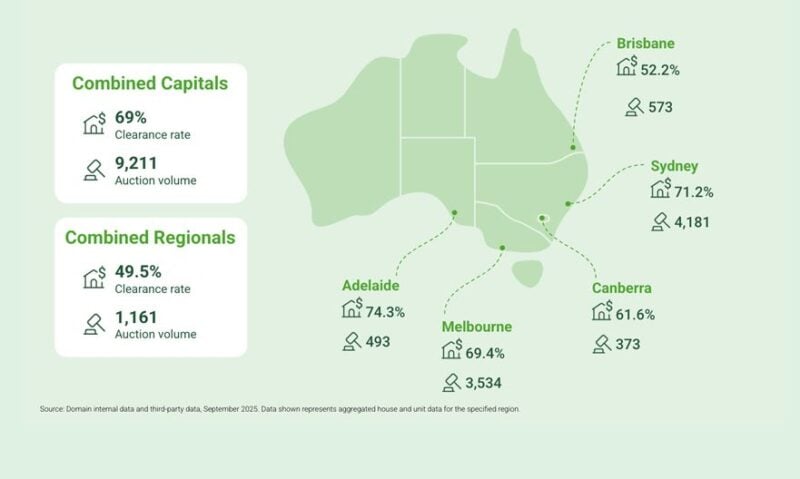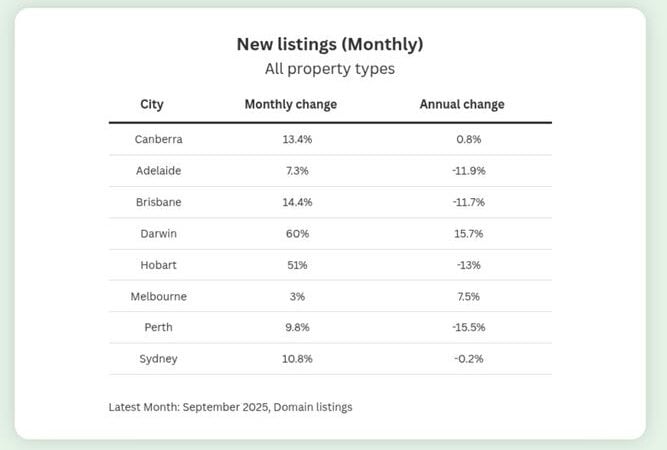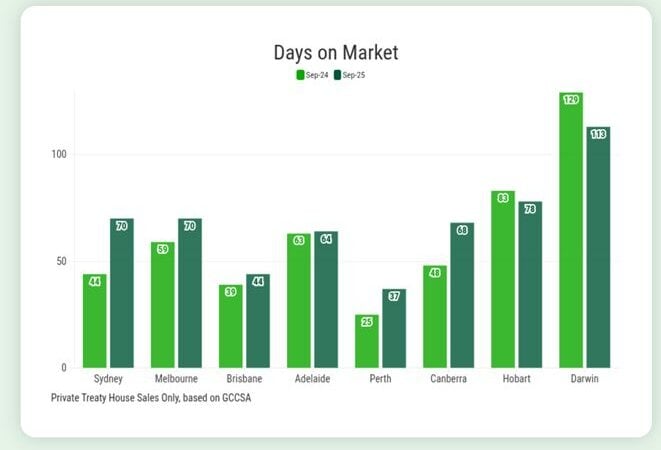
Key takeaways
Auction clearance rates across the combined capitals rose to 69%, the highest since June 2023, signalling renewed buyer confidence and stronger momentum through the spring selling season.
New property supply has increased across several cities, particularly Melbourne and Sydney, reaching six-month highs. However, total listings remain low overall, keeping competition strong among buyers.
The expansion of the 5% Deposit Scheme is bringing more first-home buyers into the market, increasing demand pressure and intensifying competition for affordable properties.
Adelaide led with the highest auction clearance rate in over two years, while Brisbane and Darwin remain highly competitive markets with record-low supply and rental vacancies below 1%.
Markets like Adelaide, Brisbane, and Darwin are moving fast with short selling times, while Canberra and Perth are experiencing longer days on market as supply rises and conditions rebalance.
There’s something about spring that breathes new life into the property market.
As the weather warms and gardens come alive, so too does buyer and seller activity.
And this year, the start of spring has truly delivered.
According to Domain’s Market Insights report for September, auction clearance rates have climbed to their highest levels since June 2023, while new property listings have surged across several capital cities.
In short, there’s more activity, more choice, and plenty of competition.
But behind the headlines, there’s a more nuanced story, one of shifting dynamics between supply, demand, and government policy that could shape the months ahead.

The Spring surge: auctions are back in full swing
Dr. Joel Bowman, Domain’s Senior Economist, summed it up neatly:
“Auction clearance rates have reached their highest levels since June 2023, reflecting renewed market momentum as we move through the spring selling season.”
Across the combined capitals, auction clearance rates rose to 69%, the strongest performance in over a year.
This suggests buyers are not just browsing, they’re bidding with confidence.
Melbourne and Sydney continue to anchor the auction scene, while Adelaide stole the spotlight with the sharpest monthly rise and its highest clearance rate in more than two years.
The increase in listings, hitting six-month highs in many cities, is giving buyers more options, but that doesn’t mean it’s getting easier to secure a home.
Demand remains intense, especially following the expansion of the Federal Government’s 5% Deposit Scheme, which is now helping more first-home buyers compete for a limited pool of quality properties.
Capital city snapshots
Let’s take a closer look at how Domain see the housing markets unfolding across the capitals.
Sydney
Sydney’s new supply hit a six-month high in September, good news for buyers wanting more choice.
But the overall picture remains one of scarcity.
Rental vacancies sit at just 0.9%, the lowest September level since 2023, and distressed listings are at their lowest since early 2022.
The city’s fundamentals remain strong, underpinned by population growth and limited new housing construction.
Melbourne
Melbourne’s market came roaring back, recording its highest supply in 11 months, the strongest jump of any capital city.
Auction clearance rates also hit their best level since mid-2023, showing solid buyer demand.
Interestingly, discounting on units fell to its lowest point since 2020, meaning sellers are holding firmer on price.
It’s another sign that Melbourne is well into its recovery phase after a more subdued period last year.
Brisbane
Brisbane saw a lift in new listings to a three-month high, yet total supply remains the lowest on record.
Buyers are competing fiercely, not just at auctions but also in the rental market, where the vacancy rate is just 0.7%.
Despite the tight supply, sellers are motivated, with auction volumes reaching their highest since 2023, a sign of market confidence.
Adelaide
Adelaide continues to defy expectations.
Its auction clearance rate hit the highest level in over two years, while houses are selling faster, with days on market falling to an eight-month low.
Although new listings have risen, they’re still lower than last year, keeping upward pressure on prices.
Add a 0.5% vacancy rate, and you’ve got one of the most competitive and resilient markets in the country.

Canberra
Canberra’s market is moving in the opposite direction, with supply surging to record highs in September.
Buyers now have more negotiating power, reflected in unit discounting reaching its highest since 2016 for this time of year.
The increased listings are taking some steam out of the market, with properties taking longer to sell and the vacancy rate rising to 1.3%.
Perth
Perth’s new listings rose to a four-month high, but overall stock remains tight.
Properties are staying on the market longer, the longest since October 2023, suggesting momentum might be easing slightly.
However, with a 0.5% vacancy rate, Perth’s rental market remains under immense pressure, and demand for well-located homes continues to outstrip supply.
Hobart
Hobart’s supply improved marginally, reaching a six-month high, but its rental market is in crisis territory.
With a 0.2% vacancy rate, it’s the tightest in the nation.
Interestingly, discounting on houses is at its lowest since 2020, showing sellers are confident, and rightly so, given the lack of available stock.
Darwin
Darwin recorded its strongest increase in new listings since June 2024, finally turning annual supply growth positive for the first time in almost a year.
Distressed listings have fallen to record lows, while the rental market remains tight at 0.4% vacancy.
The tale of two markets
One of the most telling metrics from Domain’s report is days on market.
It paints a picture of a two-speed property landscape.
Cities like Adelaide, Brisbane, and Darwin are moving quickly, homes are being snapped up almost as soon as they’re listed.
Meanwhile, Canberra and Perth are seeing longer selling times, with Canberra recording its longest since 2020.

This divergence reflects a broader truth: not all markets are equal.
Some are still booming, others are finding their balance.
And while interest rates and affordability constraints are shaping buyer behaviour, underlying demand, particularly from migration and limited construction, continues to drive competition in most cities.
The bottom line
Spring has brought with it a sense of renewed energy and optimism in Australia’s housing market.
More listings mean more opportunities, but also more competition, especially with policy measures like the 5% Deposit Scheme adding extra demand at the lower end of the market.
Buyers may be seeing more “For Sale” signs, but they’re still up against strong fundamentals: undersupply, population growth, and tight rental conditions.
So, while the market appears to be moving in a positive direction, the key for investors and homebuyers alike is to remain strategic; focus on quality assets, in high-demand locations, and think long term.
As we head deeper into spring, one thing’s clear: Australia’s property market isn’t cooling, it’s warming up right alongside the weather.














